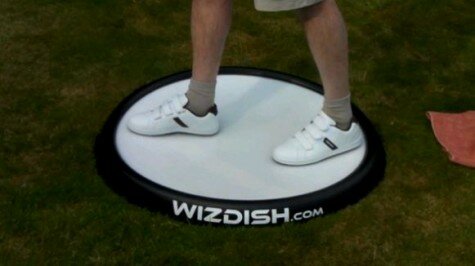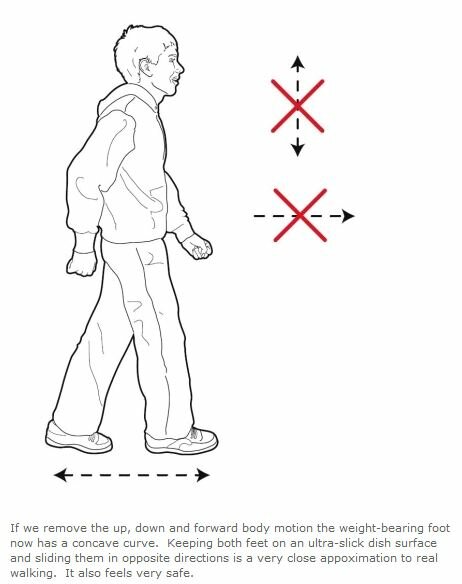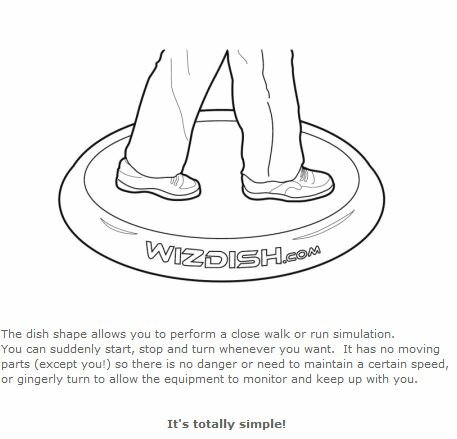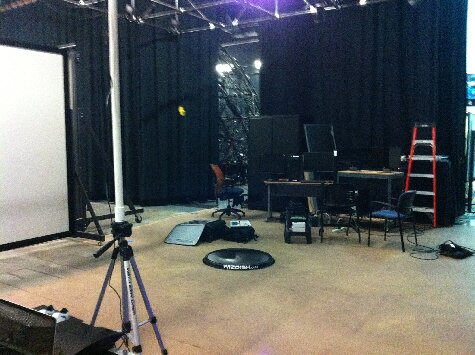Consumer friendly omni-directional WizDish heading to homes
3D NEWS> VIRTUAL REALITY
As excitement about the Oculus Rift increases, developer Julian Wiliams explains how the WizDish will make virtual reality in the home a more natural experience.
- Original idea for WizDish came from putting real contestants into video games for TV.
- Omni by Virtuix aiming at the hardcore VR fan whereas the WizDish to embrace casual users as well.
- Project Holodeck at the ICT lab has to be the coolest tech installation anywhere.
- Demand for better display technologies and motion capture will be insatiable for a long time.
- The version we offer you now probably uses less energy than normal walking.
- VR has been plagued by many snake-oil salesmen in the past with 'smoke and mirror' demos.
Soon to launch on Kickstarter now a Chinese production partner has been established, the WizDish has been in development since 2001. Thanks to the buzz surrounding the Oculus Rift, research is going into how people will navigate their way around in virtual worlds, in a more natural immersive manner than using a hand controller. Simulating walking and running by actually walking and running requires the functionality of an omni treadmill without the huge associated costs to make it consumer friendly. Julian Williams could have the answer.
The WizDish is a concave disc looking device that allows a person to walk though virtual environments by moving their legs forwards and backwards wearing super-low friction shoes.
The WizDish will be going head-to-head with the Omni by Virtuix, a device that, according to Julian, is suspiciously similar to his invention.
Julian is teaming up with an award winning documentary maker in Brighton for the Kickstarter video and UCS have just bought a WizDish to do an academic study on its physiological and psychological benefits.
In this exclusive interview, ahead of a 3D Focus TV special, we start by asking Julian how it works.
Julian Williams: Imagine I had a camcorder looking at my feet but fixed to my shoulder. My upper body will move in an arc as I take a step but because the camera is fixed, my body image will remain in place and my weight bearing foot will appear to move in a shallow dish shaped arc. Because of this ‘skating’ on the dish actually feels like real walking. Most people who’ve tried this latest version compare the action to an elliptical trainer. It isn’t quite the same as skating or cross-country skiing as you don’t lunge and your centre of gravity always stays between your feet – as it does with real walking.
We are also very excited to have been approached by Physiology experts who believe it could improve posture, balance and core stability and may even treat lower-back pain.

3D Focus: Is this not tiring to use?
Julian Williams: Many people were worried that it would be too tiring to use and they were right to be concerned. Fortunately after several years of R&D we have developed a new super low friction technology that makes the walk simulation on the WizDish less effort than real walking. Also, in VR if you just move your legs a small amount your brain is fooled into accepting that you’re walking and after moving them a little faster that you’re running! The best part is that turning is also absolutely natural so your balance and spatial awareness are preserved, and that massively enhances the experience.
FREE WEEKLY 3D NEWS BULLETIN –
An interim version won a best Tech Note award at the prestigious IEEE conference at Boston in 2010 for University College London. Something we learned from these trials was that if you step up the side of the dish it may look more natural but what’s important in VR is how it feels. The seemingly shallow incline represented something like a 1-in-10 hill which is tiring and unpleasant to do for long. UCL even had to abandon their figure 8 path and reduced it to an ‘O’ because the test subjects found it too exhausting. The version we offer you now probably uses less energy than normal walking on the flat and I can use it to walk briskly for over 2 hours without feeling particularly tired afterwards.
3D Focus: How long have you been developing the Wizdish, how did you get to this point and what is your background?
Julian Williams: The original idea for the WizDish came in 2001 and was as an idea for putting real contestants into video games for television. Back projection and chroma keying were commonplace but they needed to be able to navigate in a natural manner. I figured you could generate any situation on demand and add some jeopardy such as tipping them off into a pool. I had just come across Half-life and found the interactive cut scenes fascinating. I discovered VR in my research and have been hooked on the subject ever since. It's the ultimate entertainment technology.
My background is mostly at the BBC as a broadcast engineer and software system developer. Unfortunately TV commissioners, like many others, got burnt by premature VR and have been put off trying again.
I first applied for the patent in 2003 and delayed it as much as possible in the hope that other VR technologies would catch up. This was before Nintendo had even thought of the Wii so you can imagine how hard it to persuade people that simulated walking would add to the gaming experience.
3D Focus: Do you need special shoes for this?
Julian Williams: Yes, we have spent years finding the right combination and specification of materials to deliver the super-low friction. This was why I approached Dr. Charles King, a chartered physicist and fellow of the institute of materials. He has become as fascinated by VR as myself.
Our key design criteria were to create an omni-directional treadmill for the home that is safe, really fun to use in its own right, cheap and practical. In every design decision we’re thought “can this be done more simply?”
Over-engineering causes many more problems than sheer cost and as highly experienced engineers we know to avoid that.
3D Focus: It looks quite different to natural walking because your are not taking your feet off the floor – does this really feel like real walking?
Julian Williams: It’s impossible to gauge VR technology just by looking at it. VR isn’t a spectator sport, you have to try it first-hand. It’s about enhancing reality so you experience the best bits without any of the drawbacks. Think of war games and virtual tourism to understand what I mean. We put some videos of early prototypes on YouTube and some have commented that it doesn’t look like real walking or running. That misses the point. You only have to move your legs quite slowly to satisfy your brain that you’re walking in a game and slightly faster for running.
We want this to be something people find fun and enjoyable and not so fatiguing that it ruins the game. With some game characters running around at an equivalent of 40mph it’s just as well you don’t have to literally replicate that. The same goes for serious applications. Say that you’re training staff on safety procedures on a large oil rig. The first person perspective, proprioception and muscle memory you get using a WizDish help to lay down memory but it would be better if they didn’t leave the session exhausted.
3D Focus: How does this compare to the Omni by Virtuix?
Julian Williams: We sold an earlier WizDish prototype to Jan about a year ago and many people have remarked how similar his invention is to our patented one. As big fans of experimentation we are interested in what they're doing. They're aiming at the hardcore VR fan whereas with the WizDish we want to embrace casual users as well. I'm told the prototype base weighed about 100 pounds so it will be interesting to see how they develop the frame so it can't topple over.
3D Focus: Is it safe to use?
Julian Williams: We believe the WizDish is much safer than roller skates, trampolines, bicycles etc. and far easier to learn to use. However we are extremely safety conscious and will await the preliminary results from a Sports Technology University before approaching Kickstarter. We hope this should be in about a month.
3D Focus: Nate Burba recently gave you a demo of Project Holodeck. What did you think?
Julian Williams: We were lucky enough to take a WizDish to meet Nate Burba, a student of USC, and try their Project Holodeck at the ICT lab. That has to be the coolest tech installation anywhere. The Holodeck graphics are a little crude by triple A standards but are clearly improving all the time. I was hugely impressed by what they've achieved and it was an opportunity to experience first hand some more ideas that are bringing VR to life. I wish them every success.
3D Focus: Can you share the reaction from Palmer Luckey when you showed the WizDish?
Julian Williams: He was very enthusiastic when we took him one a couple of weeks ago. He got quite a few members of his team to try it out. Joe in particular I have to thank for reminding us of a shoe option that has become relevant because of the lower friction.
3D Focus: What future improvements would you like to see with virtual reality?
Julian Williams: Unfortunately VR has been plagued by many snake-oil salesmen in the past with 'smoke and mirror' demos but it's already possible to have a pretty good VR experience using existing HMDs and the WizDish.
I think the demand for better display technologies and motion capture will be insatiable for a long time. We've been contacted by people you wouldn't normally associate with gaming or VR who have powerful and intriguing ideas so this is going to be a fascinating space to watch.
Some of the futuristic ideas for VR aren’t new, the ancient Greeks and Romans used frescoes and plants for create a kind of mixed reality.
3D Focus: Apart from gaming, who else could make use of the WizDish?
Julian Williams: A key driver for us is and always has been comfortable use motivated by exploration and a thirst for the new. This means enabling access to millions of users whose various needs may encompass: as you have hinted – virtual tourism, visiting museums, walking around architects plans, perhaps even going shopping, meeting friends, or trekking in the Grand Canyon, training and of course gaming and the list goes on.
FREE WEEKLY 3D NEWS BULLETIN –
























